|
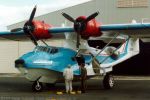 On May 17th I had been visiting family in Tauranga, and while out shopping in Devonport Road, heard the sound of a familiar aero-engine. I looked up expecting to see a DC-3, and was instead overjoyed to see the Catalina descending toward the airport. I convinced my partner that the airport would be a good place to visit, and off we went. There I had the opportunity to view the aircraft, and talk with some of the very helpful folk involved with the aircraft (notably Marlene Gray and Tony Butcher). The next day (as the Cat was there for the weekend) I took the opportunity to join the 'Friends of the Catalina' and go up in the aircraft. Before the flight, I again had the chance to tour the interior of the aircraft (I had done this previously at the Warbirds Fighter Meet at Hamilton, Easter 1995). The following is a description of the Catalina interior, showing photos from these visits (and a couple of extras from the Sportavex98 show).
On May 17th I had been visiting family in Tauranga, and while out shopping in Devonport Road, heard the sound of a familiar aero-engine. I looked up expecting to see a DC-3, and was instead overjoyed to see the Catalina descending toward the airport. I convinced my partner that the airport would be a good place to visit, and off we went. There I had the opportunity to view the aircraft, and talk with some of the very helpful folk involved with the aircraft (notably Marlene Gray and Tony Butcher). The next day (as the Cat was there for the weekend) I took the opportunity to join the 'Friends of the Catalina' and go up in the aircraft. Before the flight, I again had the chance to tour the interior of the aircraft (I had done this previously at the Warbirds Fighter Meet at Hamilton, Easter 1995). The following is a description of the Catalina interior, showing photos from these visits (and a couple of extras from the Sportavex98 show).
|
|

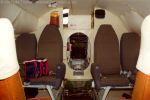 Boarding the aircraft was via the forward hatch which is located on the port side. A removable ladder allows access to the hatch, which although it looks a good size is actually quite awkward (for the flexibly challenged) to scramble through. Its about six feet off the ground and although a good width is quite low. Once aboard, I found myself in the forward passenger compartment - with seating for six - (four in two rows of two on the starboard side, and two at the rear of the compartment on the port side). Two passenger seats and the tables were removed from the aircraft after its arrival in New Zealand. The area is quite roomy. Turning left there is a short companion way to the 'office' - on either side of this this passage are two small compartments with stowage for a variety of items. There are also openings allowing you to look forward into the cockpit.
Boarding the aircraft was via the forward hatch which is located on the port side. A removable ladder allows access to the hatch, which although it looks a good size is actually quite awkward (for the flexibly challenged) to scramble through. Its about six feet off the ground and although a good width is quite low. Once aboard, I found myself in the forward passenger compartment - with seating for six - (four in two rows of two on the starboard side, and two at the rear of the compartment on the port side). Two passenger seats and the tables were removed from the aircraft after its arrival in New Zealand. The area is quite roomy. Turning left there is a short companion way to the 'office' - on either side of this this passage are two small compartments with stowage for a variety of items. There are also openings allowing you to look forward into the cockpit.
|
|
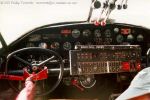
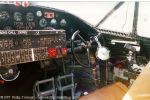 These images are taken from those openings. The cockpit appears quite large, but it is hard to tell without climbing right in. Here you can see the control panel, yokes, rudder pedals, and some of the roof mounted controls.
These images are taken from those openings. The cockpit appears quite large, but it is hard to tell without climbing right in. Here you can see the control panel, yokes, rudder pedals, and some of the roof mounted controls. |
|
The yokes are attached via the bar on which the switch covered panel can be seen - this moves backwards and forwards with the movement of the yokes.
Moving forward, it is possible to look through the low hatch into the cockpit - these 'low' level photos (below left and centre ),show the mounting for the seats (I hope the modellers appreciate these). Between the seats can be seen a 'bump' with a window at the rear. This is the top of the nose wheel bay and allows a view down onto the nose-gear. .
|
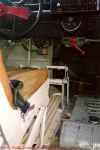
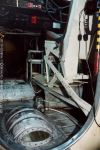
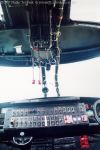
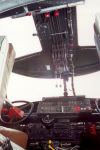
|
|
Looking up (above right ), above the control panels can be seen the various roof mounted controls (throttles etc), along with attached cables (the photo's are not too clear - but you can get the idea)
|
|
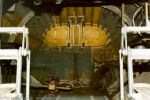 Looking forward again (left ), this image is looking forward past the rudder pedals and shows the area inside the bow. As part of the 28-5ACF conversion his aircraft has had the original nose area modified into a 'semi-clipper' bow. This has involved the removal of the turret, and replacing it with a fairing over of the nose.
Looking forward again (left ), this image is looking forward past the rudder pedals and shows the area inside the bow. As part of the 28-5ACF conversion his aircraft has had the original nose area modified into a 'semi-clipper' bow. This has involved the removal of the turret, and replacing it with a fairing over of the nose.
The image (below left ), shows rear wall of the cockpit above the access way. Note the various contols and placards fitted here.
|
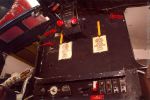
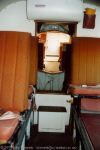 Leaving the cockpit, and moving to the rear there are four open compartments. The first is the forward passenger area where I boarded. Next is the area below the pylon to which the wing is mounted. Further back is the second passenger compartment, and finally the waist area with the blister windows.
Leaving the cockpit, and moving to the rear there are four open compartments. The first is the forward passenger area where I boarded. Next is the area below the pylon to which the wing is mounted. Further back is the second passenger compartment, and finally the waist area with the blister windows.
The image (left ), shows the view from just behind the cockpit looking aft. Note the various bulkheads, and the coamings to be negotiated.
The rear passenger compartment has seating for eight . This view looks past the rear seats and the bulkhead into the waist area between the blisters.
|
|
The left image (below ) shows the layout of the waist area - the center image gives an idea of the size and capacity of the waist compartment when occupied. Note the port blister is open. In the rear bulkhead of the waist compartment can be seen a hatch (the images show it open and closed. This leads into the stern of the aircraft, as shown in the image on the right.
|
|
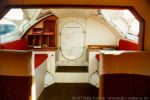
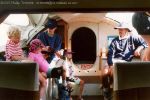
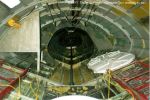
|
|
Wartime aircraft had provision in what is now the rear passenger compartment for casualty/rest bunks. A gun was sometimes carried, along with the flares and liferafts in the ventral tunnel. You will note the modern use of the area for storage. Control cables can be seen running along the top of the compartment.
|
|
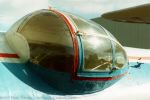
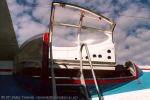
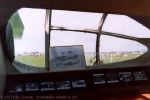
|
|
The blisters in the waist compartment provide an outstanding view from the aircraft. The bulged shape provides a clear view forward and to the rear of the aircraft. The blisters fitted are not the original 'eyelid' type, but rather hinge upwards - so they can't be opened in the air.
|
|
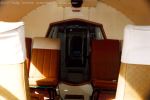
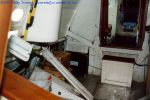 left - Moving forward again, this view shows the rear passenger compartment, and through the hatch (past various bulkheads) can be seen the other compartments leading to the cockpit.
left - Moving forward again, this view shows the rear passenger compartment, and through the hatch (past various bulkheads) can be seen the other compartments leading to the cockpit.
right - The area under the pylon is rather utilitarian - containing various lockers and areas for storage. The previous operator had this area fitted out with a stove, sink, refrigerator, and freezer which were removed after the aircraft's arrival in New Zealand. Small 'windows' open into the main wheel bays.
|
|
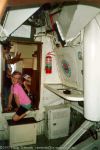
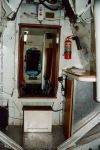
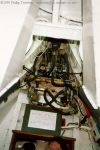 The two pictures to the left show some of the changes to the compartment in the last two years (such as the locker under the table, and above the door).
The two pictures to the left show some of the changes to the compartment in the last two years (such as the locker under the table, and above the door).
Looking up and forward (right ), the maze of hydraulic and other lines in the pylon can be seen. I don't fancy having to trace these lines.
That brings this tour to an end - the next section describes what its like to fly (as a passenger) in the Catalina.
|

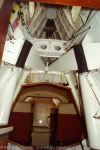
These two images looking forward (left ) and aft (right ) were made with a wider angle lens, and give a good idea of the height, and the layout in the central part of the aircraft.
|
Flying in the Cat
|
|
After wandering round the aircraft and taking some photos, I disembarked and stowed my camera bag in the Tent from which the crew were operating (thanks Marlene). It wasn't long however, before it was time to re-embark. I was one of the last aboard, and as a consequence found myself seated on the aisle in the most forward passenger seats. From where I found I could look forward into the cockpit, and I could also hear the crew engaged in running through their checks!
|
|
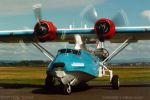 I'm not sure how long this took - I was so fascinated I wasn't taking much notice of the time. Eventually the port engine burst into life, and after a little reluctance, the starboard engine soon followed. The gentleman sitting next to me commented that they were often a little reluctant to start when warm. In our ensuring discussion, I found he had been a Quartermaster at Lauthala Bay with 6 Squadron in 1942, and had ridden aboard the Cats a time or two. As we taxied out to the runway I commented to him that 'it must be odd taking off in a Catalina from land'. He agreed!
I'm not sure how long this took - I was so fascinated I wasn't taking much notice of the time. Eventually the port engine burst into life, and after a little reluctance, the starboard engine soon followed. The gentleman sitting next to me commented that they were often a little reluctant to start when warm. In our ensuring discussion, I found he had been a Quartermaster at Lauthala Bay with 6 Squadron in 1942, and had ridden aboard the Cats a time or two. As we taxied out to the runway I commented to him that 'it must be odd taking off in a Catalina from land'. He agreed!
|
|
At the western end of the runway we turned, and the engines were run up. The aircraft then began to move forward, and I was surprised by the level of acceleration. The aircraft appears so slow that I hadn't expected it to be so strong. Liftoff seemed to be extremely quick, and despite the vibration seemed quite smooth. We climbed to about a thousand feet and turned to run down the coast toward Mount Maunganui.
|
|
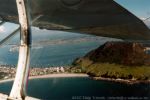 At this point we were allowed to leave our seats, and in small groups move toward the waist area. Four at a time was the suggested number. As I reached the waist, the aircraft was beginning to circle around the distinctive landmark of the Mount. By this time I was really buzzing - actually airborne in a Catalina!I found that being in the blisters was like sitting in a large 'bay-window' and the view was even better than I expected. The photographs don't really do justice to the effect.
At this point we were allowed to leave our seats, and in small groups move toward the waist area. Four at a time was the suggested number. As I reached the waist, the aircraft was beginning to circle around the distinctive landmark of the Mount. By this time I was really buzzing - actually airborne in a Catalina!I found that being in the blisters was like sitting in a large 'bay-window' and the view was even better than I expected. The photographs don't really do justice to the effect.
|
|

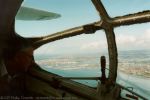 The photographs show the view forward (left ), and to the rear (right ), although at this point I was standing in the compartment rather than sitting in the blisters. We were travelling slowly enough to make out all the details below. The host of a TV fishing show (Gone Fishing) on which the Catalina appeared had commented that the speed was such that 'if you decided to get a picture, you could go and get your camera and be back in time to photograph the same scene'.
The photographs show the view forward (left ), and to the rear (right ), although at this point I was standing in the compartment rather than sitting in the blisters. We were travelling slowly enough to make out all the details below. The host of a TV fishing show (Gone Fishing) on which the Catalina appeared had commented that the speed was such that 'if you decided to get a picture, you could go and get your camera and be back in time to photograph the same scene'.
|
|
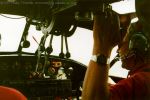 After five or ten minutes we rearranged ourselves to let other passengers into the waist compartment, so I then moved forward. Standing on the step in the compartment behind the cockpit, I took the opportunity to watch the action in the cockpit. This is a cool way to fly! The aircraft flew inland over the harbour, past the Matua peninsula and over Greerton, before turning back into the circuit, approaching over the Central City.
After five or ten minutes we rearranged ourselves to let other passengers into the waist compartment, so I then moved forward. Standing on the step in the compartment behind the cockpit, I took the opportunity to watch the action in the cockpit. This is a cool way to fly! The aircraft flew inland over the harbour, past the Matua peninsula and over Greerton, before turning back into the circuit, approaching over the Central City.
|
|
 So it was time to return to my seat. As we descended the gear was lowered - at this point I could see down through the small window at the top of the nose-gear bay. A particularly strange view to have as we came over the threshold. The landing was quite smooth, and it didn't take long to taxy-in. As I climbed out I found my partner (left ), videoing the proceedings. From chock to chock the trip was about half an hour - so that meant twenty or twenty-five minutes in the air. I can only say it was a wonderful experience, and I'm looking forward to doing it again! If you get the chance - take it.
So it was time to return to my seat. As we descended the gear was lowered - at this point I could see down through the small window at the top of the nose-gear bay. A particularly strange view to have as we came over the threshold. The landing was quite smooth, and it didn't take long to taxy-in. As I climbed out I found my partner (left ), videoing the proceedings. From chock to chock the trip was about half an hour - so that meant twenty or twenty-five minutes in the air. I can only say it was a wonderful experience, and I'm looking forward to doing it again! If you get the chance - take it.
|
|
Thankyou to Marlene Gray for talking me into this, and to the crew Chris Snelson, Dave Jenkins, and Tony Butcher for chatting with me. More information on the Catalina's operation can be found here.
|
A Cat on the Water
|
|
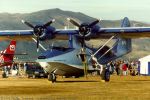
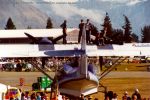 ZK-PBY was one of the many participants at the 1998 Warbirds over Wanaka airshow held over the Easter Weekend. Prior to the show, the aircraft traded its blue and red 'Peter Stuyvesant' colours for a more military three-tone appearance. As part of the Russian theme of the airshow, this was embellished with temporary Soviet red star and CCCP markings. The crew and supporters also appeared in 'Catalinski' t-shirts.
ZK-PBY was one of the many participants at the 1998 Warbirds over Wanaka airshow held over the Easter Weekend. Prior to the show, the aircraft traded its blue and red 'Peter Stuyvesant' colours for a more military three-tone appearance. As part of the Russian theme of the airshow, this was embellished with temporary Soviet red star and CCCP markings. The crew and supporters also appeared in 'Catalinski' t-shirts.
|
|
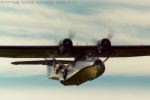 Although I enjoyed the Catalina's displays at the airshow, the real highlight came on the following Monday. My informants had told me that as part of the regular club flights onto Lake Wanaka during the morning, one flight would carry Sir Tim Wallis (founder of the Alpine Fighter Collection and originator of the airshow) and involve bringing the aircraft into the beach at Wanaka township. The tip said 10.00am was the time, so I made sure I was down at the water's edge.
Although I enjoyed the Catalina's displays at the airshow, the real highlight came on the following Monday. My informants had told me that as part of the regular club flights onto Lake Wanaka during the morning, one flight would carry Sir Tim Wallis (founder of the Alpine Fighter Collection and originator of the airshow) and involve bringing the aircraft into the beach at Wanaka township. The tip said 10.00am was the time, so I made sure I was down at the water's edge.
|
|
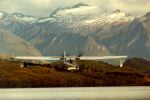 Sure enough, I was soon rewarded by the wonderful drone of the Pratt & Whitney engines, as the aircraft passed low overhead, and swept down the lake. The magnificent sight of a rooster tail of water as the aircraft touched down soon followed.
Sure enough, I was soon rewarded by the wonderful drone of the Pratt & Whitney engines, as the aircraft passed low overhead, and swept down the lake. The magnificent sight of a rooster tail of water as the aircraft touched down soon followed.
Unfortunately, this was several kilometres away, and so I can't share a photo. I can tell you it is a sight worth seeing!
|
|
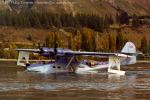 However, before long the aircraft had turned and made its way in stately fashion up the lake towards us. This was my first sight of a Catalina on the water. It certainly fitted the scene!
However, before long the aircraft had turned and made its way in stately fashion up the lake towards us. This was my first sight of a Catalina on the water. It certainly fitted the scene!
The water at the lakes edge slopes too shallowly to float the aircraft, so as it approached the beach the wheels were lowered, and it effectively taxied across the lakebed to the beach.
|
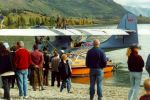
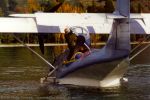 A line was run ashore to a convenient tree to ensure this 'boat' didn't drift away. A good size crowd soon gathered - both on the beach and the water, as people on foot and in boats sped in to check out the amphibian visitor.
A line was run ashore to a convenient tree to ensure this 'boat' didn't drift away. A good size crowd soon gathered - both on the beach and the water, as people on foot and in boats sped in to check out the amphibian visitor.
|
|
 With the starboard blister opened, the special guest came out to say hello to the crowd. At this stage Sir Tim was still recovering following his crash in January 1996 in Spitfire XIV NH799. He appeared in good spirits, waving and talking to various people.
With the starboard blister opened, the special guest came out to say hello to the crowd. At this stage Sir Tim was still recovering following his crash in January 1996 in Spitfire XIV NH799. He appeared in good spirits, waving and talking to various people.
At this point I had a good laugh. I have pointed out Sir Tim to a number of people at various events. However, I overheard Marlene Gray (whom I correspond fairly regularly with), pointing me out to Sir Tim. In fact that had me chuckling for the rest of the day!
|
|

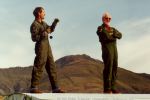

In the meantime, the crew and supporters aboard the aircraft took the opportunity to chat with spectatators, and get a few photos. The top of the wing seemed a popular vantage point to get group photos with the spectacular scenery in the background. Some of the crew can be seen above - including Chris Snelson, David Clews, Laurence Ackett, Tony Butcher and Bruce Sinton.
|
|

 After half an hour or so, the crew started to close up the aircraft, and the spectators were warned to move away. Some didn't, and were obviously unaware of what effect two props on 1200hp engines above that much water can have. Sand and spray were flying! The aircraft moved off and we watched it haul itself across a kilometre or two of water before it climbed into the air. The water streamed off the airframe for quite a while! PBY circled and then made a low pass before heading back toward the airfield.
After half an hour or so, the crew started to close up the aircraft, and the spectators were warned to move away. Some didn't, and were obviously unaware of what effect two props on 1200hp engines above that much water can have. Sand and spray were flying! The aircraft moved off and we watched it haul itself across a kilometre or two of water before it climbed into the air. The water streamed off the airframe for quite a while! PBY circled and then made a low pass before heading back toward the airfield.
|
On May 17th I had been visiting family in Tauranga, and while out shopping in Devonport Road, heard the sound of a familiar aero-engine. I looked up expecting to see a DC-3, and was instead overjoyed to see the Catalina descending toward the airport. I convinced my partner that the airport would be a good place to visit, and off we went. There I had the opportunity to view the aircraft, and talk with some of the very helpful folk involved with the aircraft (notably Marlene Gray and Tony Butcher). The next day (as the Cat was there for the weekend) I took the opportunity to join the 'Friends of the Catalina' and go up in the aircraft. Before the flight, I again had the chance to tour the interior of the aircraft (I had done this previously at the Warbirds Fighter Meet at Hamilton, Easter 1995). The following is a description of the Catalina interior, showing photos from these visits (and a couple of extras from the Sportavex98 show).
Boarding the aircraft was via the forward hatch which is located on the port side. A removable ladder allows access to the hatch, which although it looks a good size is actually quite awkward (for the flexibly challenged) to scramble through. Its about six feet off the ground and although a good width is quite low. Once aboard, I found myself in the forward passenger compartment - with seating for six - (four in two rows of two on the starboard side, and two at the rear of the compartment on the port side). Two passenger seats and the tables were removed from the aircraft after its arrival in New Zealand. The area is quite roomy. Turning left there is a short companion way to the 'office' - on either side of this this passage are two small compartments with stowage for a variety of items. There are also openings allowing you to look forward into the cockpit.
These images are taken from those openings. The cockpit appears quite large, but it is hard to tell without climbing right in. Here you can see the control panel, yokes, rudder pedals, and some of the roof mounted controls.
Looking forward again (left ), this image is looking forward past the rudder pedals and shows the area inside the bow. As part of the 28-5ACF conversion his aircraft has had the original nose area modified into a 'semi-clipper' bow. This has involved the removal of the turret, and replacing it with a fairing over of the nose.
Leaving the cockpit, and moving to the rear there are four open compartments. The first is the forward passenger area where I boarded. Next is the area below the pylon to which the wing is mounted. Further back is the second passenger compartment, and finally the waist area with the blister windows.
left - Moving forward again, this view shows the rear passenger compartment, and through the hatch (past various bulkheads) can be seen the other compartments leading to the cockpit.
The two pictures to the left show some of the changes to the compartment in the last two years (such as the locker under the table, and above the door).